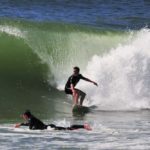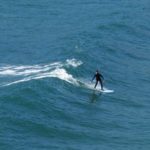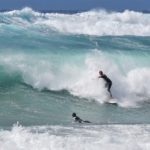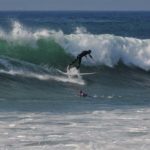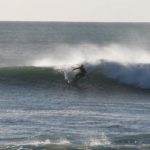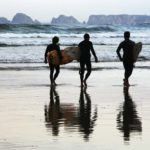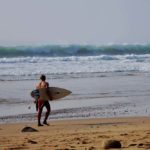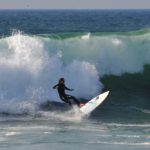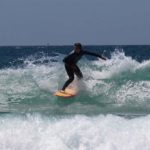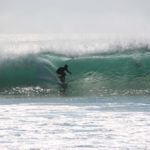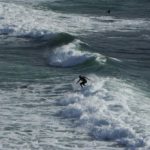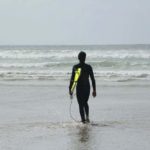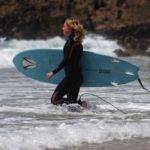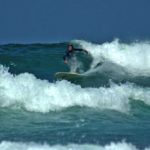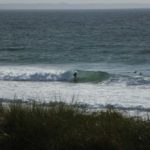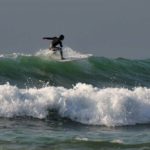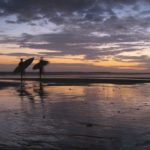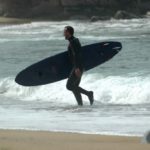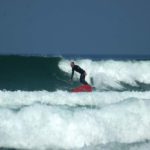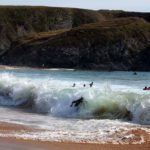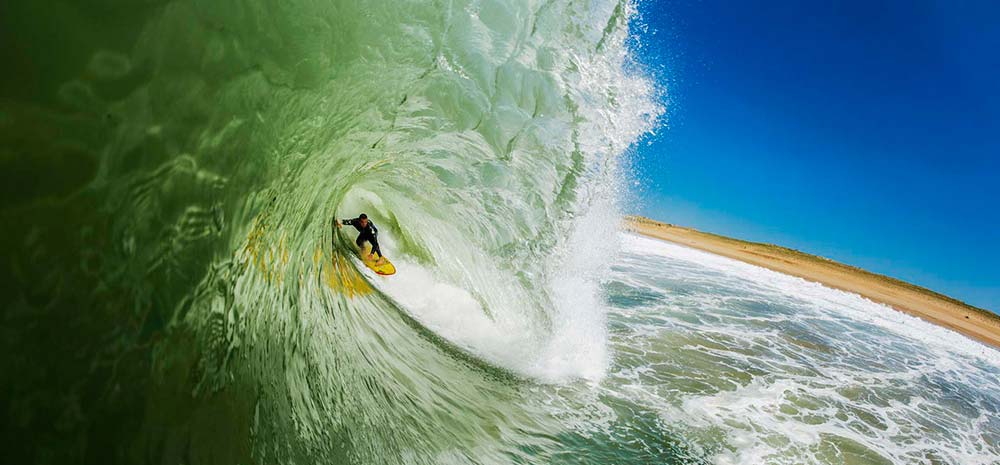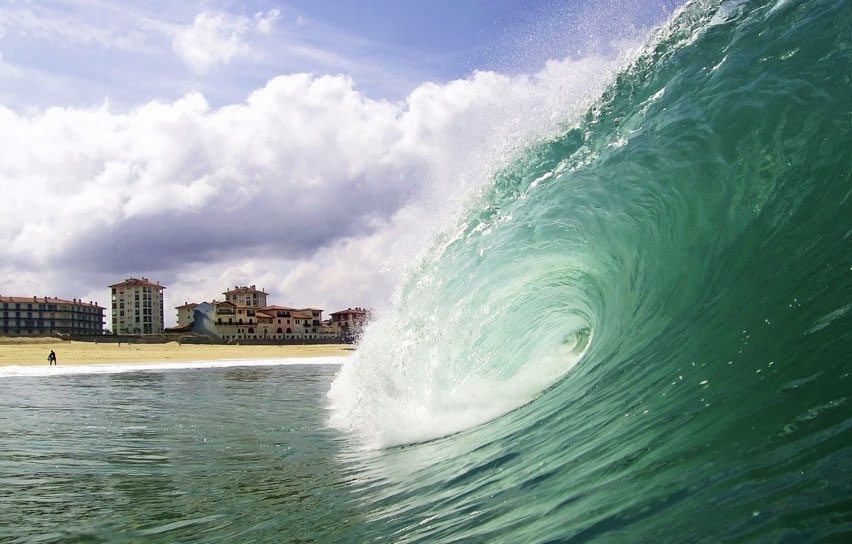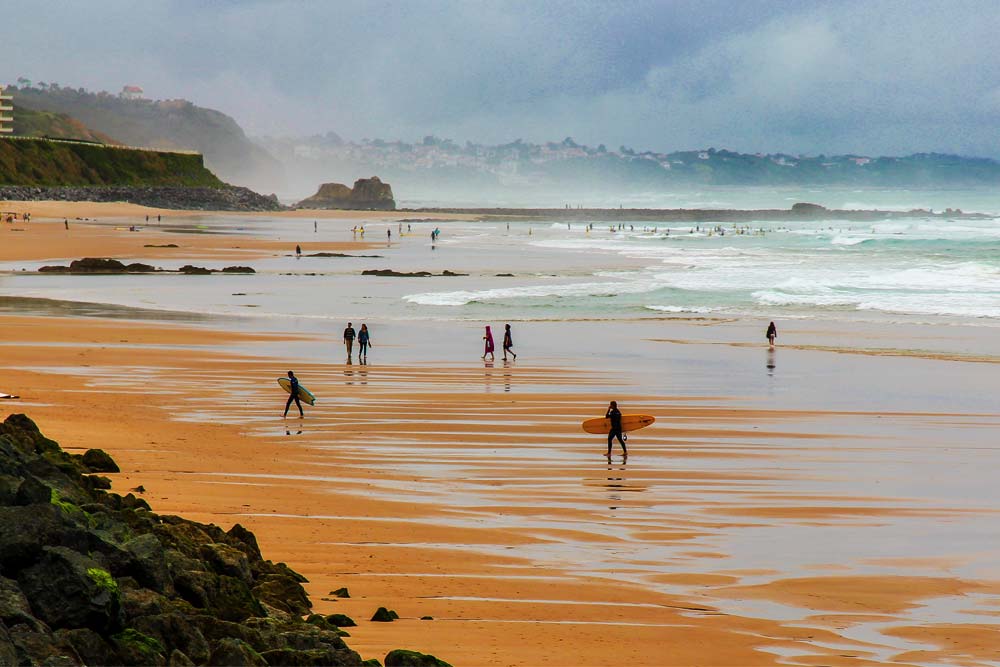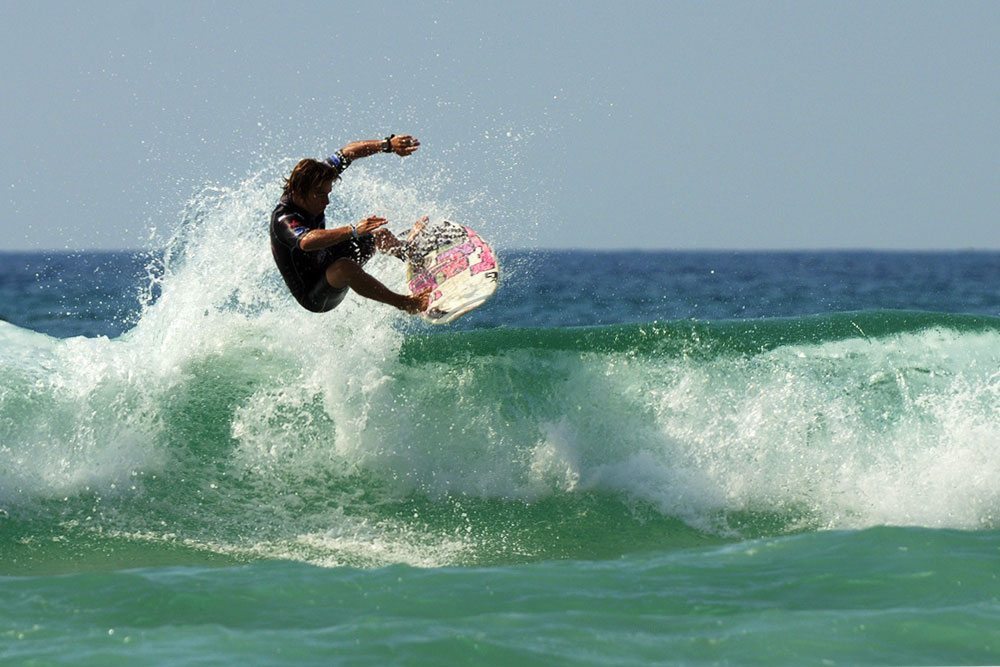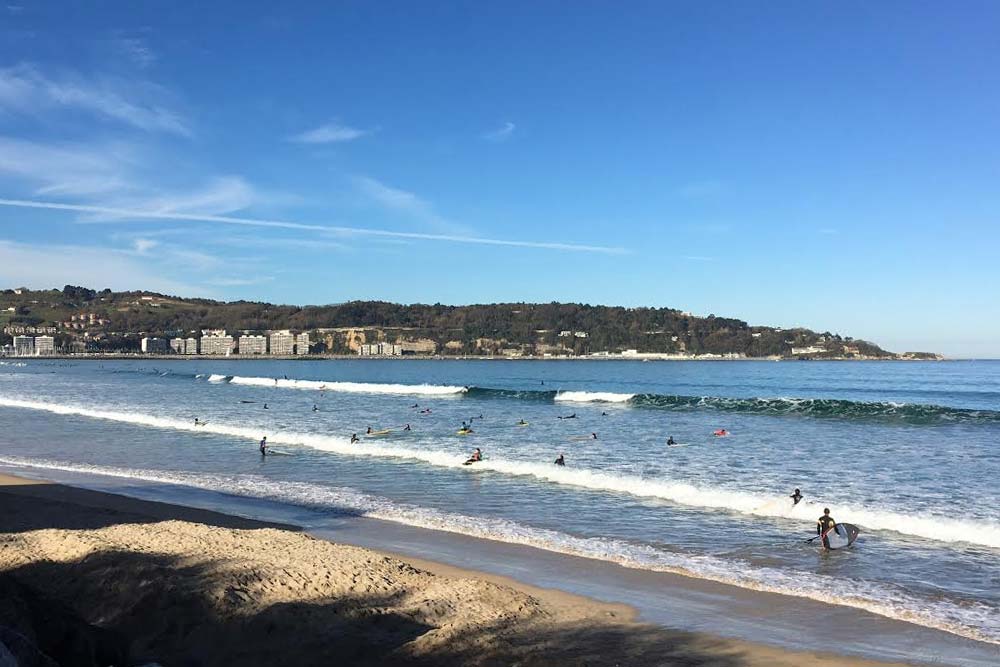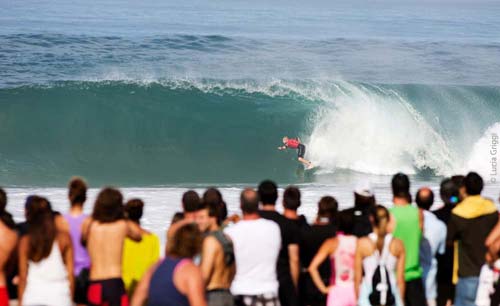The best Surf Spots along Brittany’s Coast
With good consistent surf and wild, rugged landscapes, Brittany is one of France’s top surfing destinations.
Brittany’s rugged coastline is chock full of surf spots. Some are exposed to the full force of the Atlantic Ocean, whilst others are more sheltered. There are sandy beach breaks, sweeping point breaks and reef breaks. Whatever the forecast, in Brittany you never have to drive very far to find a wave.
If the weather’s off, you can head to a cove that’s protected from the wind. If the wind’s blowing in from the south, head to a southern facing beach. So get your wetsuit and board packed and head to Brittany for an unforgettable surf trip.
Local surfers are on the whole very welcoming to travelling wave hunters. A ‘bonjour’ and a smile will go a long way to getting you the lowdown on the best spot for the conditions on the day. And, it’s worth seeking out that local knowledge. The jagged coastline serves up so many options that it’s easy to burn time looking around for the perfect wave. You can also get the latest info on any hazards like rips and rocks.
In Brittany you can really find all types of wave to surf. From nice, friendly beach breaks to highly engaging and barrelling reef breaks. When the conditions line up, you can have a magic session in a stunning setting.
You still get the benefits of the Gulf Stream in Brittany, but the water’s a couple of degrees colder than it is in south-west France. You can surf all year round, but in winter the swells are bigger, the waves carry more power and you’ll be glad you packed your winter wetsuit and booties.
Surfing in North Brittany
Northern Brittany isn’t the most famous part of France for surfing, but there are some hidden gems and a trip off the beaten track is well worth it. Wild and windswept it can be difficult to get your bearings. But, if you don’t mind exploring the ins and outs of the coastline, you’ll discover some magical and uncrowded surf spots. Break out of your comfort zone and hit up Northern Brittany. Here are the region’s best spots:
Surfing in Le Sillon, Saint Malo
Le Sillon is an easily accessible spot close to the centre of Saint-Malo. Some might say that’s too easily accessible as it can be hard to find a parking space. The best time of year to surf here is autumn on an incoming tide. The spot is good for both beginners and good surfers. There are no particular hazards to be aware of. To reach the spot head to Boulevard Hébert, there’s on-street parking and a surf school near the Thermes Marins de Saint-Malo.
Spot type: Beachbreak. Offshore wind: Easterly. Bottom type: Sand.Best tide: Mid. Wave size: 1 to 2.5 m.Lat Long: 48.657545, -2.013916.Nearest town: Saint Malo.
Surfing in Longchamp, Saint Lunaire
This is primarily a beach break, but there are some rocky slabs in the water which produce a more hollow and powerful wave. The best time to surf the spot is on an incoming tide. It’s best avoided in the height of summer when the shallows are saturated with swimmers. Good intermediate surfers can ride here, but watch out for concealed boulders. Access the spot via Boulevard de Longchamp in Saint-Lunaire.
Spot type: Beach/reef. Offshore wind: Easterly. Bottom type: Sand.Best tide: Mid to High. Wave size: 1.5 to 3.0 m.Lat Long: 48.636856, -2.121484.Nearest town: Saint Lunaire.
Surfing in Perros-Guirec
In Perros-Guirec you’ll find an easy to reach shorebreak that can get pretty big. Nicely satisfying for good surfers, but it can catch beginners out. You just need to match your surfing ability with the conditions before paddling out. The best time to surf here is from autumn through to spring on an incoming tide. There’s parking and shower facilities close to the beach. Watch out for the dumping shories when paddling out. Access the spot via Boulevard Joseph Le Bihan.
Spot type: Beach. Offshore wind: Easterly. Bottom type: Sand. Best tide: Mid. Wave size: 1.5 to 3.0 m.Lat Long: 48.819890, -3.455545. Nearest town: Perros Guirec.
Surfing in Moulin de la Rive, Locquirec
The Moulin de la Rive beachbreak offers pretty good winter surfing conditions between September and June. Best surfed close to low tide, whether outgoing or incoming. Watch out for strong currents. The spot is best suited to intermediate and advanced surfers. Access the spot via Rue de la Corniche. There’s parking near the beach.
Spot type: Beach. Offshore wind: Easterly. Bottom type: Sand. Best tide: Low to Mid. Wave size: 1.5 to 3.0 m.Lat Long: 48.687319, -3.676648. Nearest town: Locquirec.
Surfing in Primel-Trégastel
Primel-Trégastel often gets some nice little waves making it a good spot for beginners. You can surf here year round, but to get it at its best, aim to hit it on an incoming tide with a southerly wind. Access the spot via Promenade de la Meloine. There’s parking near the beach.
Spot type: Beach. Offshore wind: Easterly. Bottom type: Sand. Best tide: Low to Mid. Wave size: 1.5 to 3.0 m.Lat Long: 48.713000, -3.811793. Nearest town: Trégastel.
Surfing in La Mauvaise Grève, Moguériec
La Mauvaise Grève is one of the most technical spots in Northern Brittany. No surprise then that it’s not for everyone. Confident intermediate and advanced surfers will love it, but it’s not for beginners. At low tide La Mauvaise Grève is a straightforward beachbreak with nothing to write home about. But at high tide, the spot becomes a reef break with all the hazards that brings with it. Access via Rue du Theven.
Spot type: Beach/ reef. Offshore wind: Easterly. Bottom type: Sand. Best tide: Low to High. Wave size: 1 to 3.0 m.Lat Long: 48.691130, -4.085127. Nearest town: Moguériec.
Surfing in Penful, Landavez
Penful is a great year round surf spot accessible to everyone, even though it’s better to have a bit of surfing experience under your belt. It’s a beach break and there are no particular dangers. Best surfed on an incoming tide. Beginner and intermediate surfers will love this spot. There’s parking close to the beach.
Spot type: Beach. Offshore wind: Easterly. Bottom type: Sand. Best tide: Mid to High. Wave size: 1 to 3.0 m.Lat Long 48.519404, -4.759883. Nearest town: Penful.
Surfing in les Blanc-Sablons, Le Conquet
Les Blanc-Sablons is a beachbreak that’s fully exposed to Atlantic swells with a strong dominant north-westerly wind. Best surfed on an incoming tide. There’s the odd rock to watch out for so go easy on the stylish dismounts until you get your bearings. The spot is geared towards intermediate and advanced surfers. There’s parking near the break.
Spot type: Beach. Offshore wind: North/ North West. Bottom type: Sand. Best tide: Mid to High. Wave size: 1 to 2.5 mLat Long: 48.370369, -4.766221. Nearest town: Le Conquet.
Surfing in Le Petit Minou – Brest
Le Petit Minou has to be one of Brittany’s most famous surf spots. It’s proximity close to the popular tourist town of Brest means it can get crowded in summer. The spot works best at low tide and a north-easterly wind. There’s parking and showers at the beach. Access the spot via Route du Minou.
Spot type: Beach. Offshore wind: Easterly. Bottom type: Sand. Best tide: Mid to High. Wave size: 1 to 3.0 mLat Long: 48.347801, -4.667664. Nearest town: Brest.
Surfing in Lostmarc’h – Morgat
Lostmarc’h is in a spectacular location and well worth checking out. The waves here pack a punch and you need at least intermediate surfing ability. The spot holds swell up to 3.5 metres and it can be windy with a lot of water moving around. You can surf Lostmarc’h all year round, but the break is packed in the height of summer.
Spot type: Beach. Offshore wind: North Est. Bottom type: Sand. Best tide: Mid to High. Wave size: 1 to 3.5 mLat Long: 48.216929, -4.550979. Nearest town: Morgat.
Surfing in South Brittany
South Brittany is renowned for having some great surf spots and consistent swell. You can expect quality waves and stunning scenery. The jagged coastline means conditions vary a lot in a short distance. To hit it at its best, try to get some local info on the best spot on the day. Once you’ve spent a bit of time here, you’ll naturally start to work out where works best at what tide, swell height and wind direction. The good thing is, there’s almost always somewhere that’s working. So, get out there and explore and remember to consult the locals.
Surfing in Baie des Trépassés – Lescoff
The Baie des Trépassés is a sheltered beach break in a wild part of Brittany. It’s a favourite winter spot for surfers from this part of France. Big waves roll in on the back of a strong north-westerly wind. Low tide from autumn to spring produces the best conditions. Watch out for strong currents.
Spot type: Beach. Offshore wind: North/ North West. Bottom type: Sand. Best tide: Low. Wave size: 1 to 3 mLat Long: 48.046467, -4.708424. Nearest town: Lescoff.
Surfing in Saint Tugen
Saint Tugen is another Brittany surf spot with a solid reputation. It’s a beach-break directly exposed to the swell that will appeal to both surfers and bodyboarders. Aim to surf it on an incoming tide in a north-easterly wind. It’s a spot for intermediate to good surfers.
Spot type: Beach. Offshore wind: Easterly. Bottom type: Sand. Best tide: Mid. Wave size: 1 to 2.5 mLat Long: 48.021722, -4.592369. Nearest town: Saint-Tugen.
Surfing in La Torche, Ploemer
When you talk about surfing in Brittany, La Torche is often the first place you think of. It’s a huge beach with peaks popping off all over the place. On the right day, you can get some really long rides at La Torche. There’s a bit of current but the spot is accessible to everyone from beginner to pro. There’s parking at the beach and lots of surf schools offering lessons and board rental. It gets busy in summer but there’s plenty of room to spread out.
Spot type: Beach. Offshore wind: Easterly. Bottom type: Sand. Best tide: Mid to High. Wave size: 1 to 2.5 mLat Long: 47.840082, -4.34756647. Nearest town: Ploemer.
Surfing in Guidel Plage – Fort Bloqué
Guidel Plage is one of the best places in Brittany to learn to surf. The huge shallow beach serves up some long gentle waves that allow you to make quick progress. It’s best surfed at low tide or on an incoming tide. The beach gets crowded in the summer, but you don’t need to walk far to find a quiet peak. Best for beginners and intermediates.
Spot type: Beach. Offshore wind: Esterly. Bottom type: Sand. Best tide: Low to Mid. Wave size: 1 to 2.5 mLat Long: 47.767755, -3.521884. Nearest town: Fort Bloqué.
Surfing in Pointe des Kaolin – Ploemeur
La pointe des Kaolin is a powerful reef break suitable mainly for good surfers. The dominant westerly wind delivers big swells and the waves can be impressive. You’ll often see bodyboarders kicking in at the last second and slotting in to steep, chunky barrels. There’s parking near the spot.
Spot type: Reef. Offshore wind: West. Bottom type: Sand. Best tide: Mid to High. Wave size: 1 to 3 mLat Long: 47.714118, -3.481000. Nearest town: Ploemeur.
Surfing Lines – Plouhinec
Lines is a sheltered spot that works best in winter swells between September and June. Direct swell is blocked by l’Ile de Groix, an island a few kilometres off the coast of the Pointe de Gâvres peninsula. It’s a rare day that this spot works well, but when the conditions line up, you can get some great waves. Ideal for beginners and intermediate surfers. All the same, be aware of the strong currents.
Spot type: Beach. Offshore wind: Easterly. Bottom type: Sand. Best tide: Mid to High. Wave size: 2 to 4 mLat Long: 47.665651, -3.252626. Nearest town: Plouhinec.
Surfing in La Barre d’Etel
La Barre d’Etel is in an estuary and as a result it’s a very technical wave. The strong currents that help produce the wave make the spot quite dangerous and you need make sure you’re paddle fit before heading out. The spot works best in a northerly wind and an incoming tide. Advanced surfers only.
Spot type: Beach. Offshore wind: Easterly. Bottom type: Sand. Best tide: Mid to High. Wave size: 1 to 2.5 mLat Long: 47.642255, -3.214538. Nearest town: Etel.
Surfing in Sainte-Barbe – Plouharnel
Sainte-Barbe-Plouharnel is a beach break that seems made for beginners. Reassuring waves that are easy to catch and not too steep roll in for a good distance up the shallow beach. Aim to hit the spot on an incoming tide in a north-easterly wind. It’s a year-round spot but it most consistent in the winter months. The perfect spot for learning to surf.
Spot type: Beach. Offshore wind: Easterly. Bottom type: Sand. Best tide: Mid. Wave size: 1 to 2.5 mLat Long: 47.607238, -3.136830. Nearest town: Plouharnel.
Surfing in Port Rhu – Quiberon
Port Rhu is the hardest spot to get to grips with on the Quiberon peninsula. The paddle out is tricky with powerful waves that can push you towards the cliffs. You need some space around you if you want to surf here safely, so best avoided if it’s too crowded. Recommended for good surfers only.
Spot type: Beach. Offshore wind: Easterly. Bottom type: Sand. Best tide: Mid. Wave size: 1 to 2.5 mLat Long: 47.516045, -3.152533. Nearest town: Quiberon.
Surfing in Donnant – Belle-ïle-en-Mer
Donnant beach is well worth the return trip by boat from Quiberon. A westerly facing beach break, it gets lots of swell and good sized waves. There’s some powerful rips to watch out for. Surfers can use them to get out back, but strong currents can also push you towards the rocks. Pick a marker on the beach and stay vigilant. Beginners should favour a high tide, the rest of the time it’s only suited to intermediate and advanced surfers.
Spot type: Beach. Offshore wind: Easterly. Bottom type: Sand. Best tide: Mid. Wave size: 1 to 2.5 mLat Long: 47.325789, -3.238298. Nearest town: Belle-Ile-en-mer.
Please leave a comment below if you need specific advice for your surf trip to Brittany, or if you have any recommendations to help us improve this guide. Bonnes vacances!


